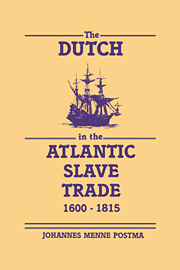Book contents
- Frontmatter
- Contents
- List of tables, figures, and maps
- Preface
- 1 Foundations of the slave traffic, 1600–61
- 2 Curaçao and the asiento trade, 1650–1730
- 3 The Dutch on the West African coast
- 4 Trade and politics on the African coast
- 5 Volume of African exports and origins of slaves
- 6 Organization and mechanics of the trade
- 7 The triangular trade
- 8 The Dutch plantation colonies under WIC monopoly, 1618–1738
- 9 The era of the free trade, 1730–80
- 10 The slaves: their treatment and mortality
- 11 Finances, marketing, and profitability
- 12 The end of the Dutch slave trade, 1781–1815
- Appendixes
- Bibliography
- Index
12 - The end of the Dutch slave trade, 1781–1815
Published online by Cambridge University Press: 16 September 2009
- Frontmatter
- Contents
- List of tables, figures, and maps
- Preface
- 1 Foundations of the slave traffic, 1600–61
- 2 Curaçao and the asiento trade, 1650–1730
- 3 The Dutch on the West African coast
- 4 Trade and politics on the African coast
- 5 Volume of African exports and origins of slaves
- 6 Organization and mechanics of the trade
- 7 The triangular trade
- 8 The Dutch plantation colonies under WIC monopoly, 1618–1738
- 9 The era of the free trade, 1730–80
- 10 The slaves: their treatment and mortality
- 11 Finances, marketing, and profitability
- 12 The end of the Dutch slave trade, 1781–1815
- Appendixes
- Bibliography
- Index
Summary
Crucial changes were taking place in the Dutch slave trade during the decade of the 1770s. At the beginning of the decade the traffic reached an all-time high, but as an economic recession struck, in 1773, Dutch slaving activity declined significantly. The diplomatic fallout of the American Revolution, which put additional strains on Atlantic shipping, also had a retarding effect on the Dutch slave trade. In 1780 the Dutch Republic openly chose the side of the American colonies and got involved in a war with Great Britain, bringing the Dutch slave trade to a temporary halt.
The final decades of the Dutch slave trade
The Fourth Anglo-Dutch War (1780–4) was disastrous for the Dutch Republic. British naval power far outdistanced the Dutch navy. The still large Dutch merchant marine was relatively unprotected, and numerous Dutch ships were captured and confiscated by the enemy. The capture of at least twelve Dutch slave ships during the years 1780 to 1783 has been verified, and the fate of at least three other slavers is uncertain, but they were undoubtedly captured as well. The MCC alone lost at least six slave ships to the British. Several Dutch colonial territories were taken over by Great Britain, including the settlements in Guyana and the island of St. Eustatius, which had initially played a prominent role in supplying the American rebels.
Table 12.1 gives a statistical display of the much-reduced volume of the Dutch slave trade during its final years.
- Type
- Chapter
- Information
- The Dutch in the Atlantic Slave Trade, 1600–1815 , pp. 284 - 303Publisher: Cambridge University PressPrint publication year: 1990



